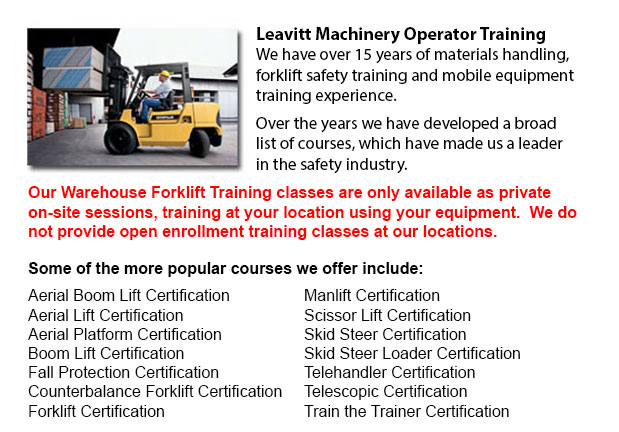
Nanaimo Warehouse Forklift Safety Training - The business will face claims for liability when injuries and damage are sustained in an accident at the workplace. Warehouses could be a dangerous place to work for its employees, making employee safety a top priority for the company. Warehouse safety training is one of the most effective ways to protect personnel, while minimizing expenses associated with injuries and accidents.
The warehouse holds large amounts of stock and materials which could pose dangers, particularly when these are being moved. The transporting of stock with a powered machinery or by hand can result in injuries the workers' hands, fingers, toes and feet. Falling, slipping and tripping are common causes of injury. Heavy objects could fall off shelves and harm personnel. Forklifts and other equipment carry inherent hazards as they manipulate heavily laden pallets. Wrong lifting is a common source of back injuries. Even box cutters, nails and splinters could cause harm.
Depending upon the goods and materials which are being handled, the conditions of the warehouse could change from one minute to the next, specially with the equipment being utilized and the tasks being performed. Because of the various possible hazards in warehouse settings, warehouse operations are regulated by many various standards. There are rules for material handling and storage, for walking and working surfaces, and regulations governing the use and selection of PPE (personal protective equipment).
The majority of the safety rules covered by a business will consist of common sense rules. Regulations that warehouse workers should be quite familiar with include:
1. When working in a warehouse, safety is a priority at all times.
2. When work calls for proper PPE, like for example safety shoes, gloves, eye protection and hard hats, they should be worn.
3. Check for hazards and report them or correct them.
4. Observe and Follow warning signs and signals.
5. Pay attention to the job you are performing.
6. Pay attention to what others are performing nearby - specially forklifts and various dangerous machinery.
7. Store and stack materials so that they're stable and secure.
Following good housekeeping rules will help to ensure a safe warehouse for all staff. Basic housekeeping regulations include keeping floors and aisles clear of items, like for instance wires and cords. Never perch things insecurely on a surface. When spills take place, clean up right away. Dispose of garbage in right containers. Keep fire extinguisher, sprinklers and fire exits accessible. Put box cutters and various sharp tools away instantly after using. Report tripping hazards such as loose or damaged flooring.
-
Nanaimo Boom Lift Certification
Nanaimo Boom Lift Certification - Using elevated work platforms allow for maintenance operations and work to be carried out at elevated work heights which were otherwise not reachable. Workers making use of scissor lifts and boom lifts can learn how... More -
Nanaimo Boom Lift Safety Training
Nanaimo Boom Lift Safey Training - Boom lifts are a kind of aerial lifting device or elevated work platform which are commonly used in industry, warehousing and construction. Boom lifts could be utilized in practically whichever environment because o... More -
Nanaimo Loader Operator Training
Nanaimo Loader Operator Training - Loader Operator Training - Forklift training is a prerequisite within North America and is intended to prevent workplace death and injuries. Lift truck training provides driver training intended for forklift operato... More -
Fall Protection Certification in Nanaimo
There are high numbers of injuries at work associated to falling and lots of fall-related deaths reported each and every year. Most of these instances might have been prevented with better training, better measures in place, and by properly equipping... More -
Nanaimo Crane Ticket
Nanaimo Crane Ticket - The modern version of a crane can be either complex or simple, and cranes vary based on their use. Mobile cranes, for example are rather simple. A telescopic boom or steel truss mounts its movable platform. A system of levers o... More -
Operator Safety Certification | Re-Qualification Certification | In-House Instructor Certification in Nanaimo
Lift trucks are used in practically all industrial construction sites and in warehouse operations and in boat yards. The reach feature of a forklift is a very important part utilized in several applications like when a shelving system is being used t... More -
Aerial Lift / Boom Lift / Man Lift / Scissor Lift Certification in Nanaimo
Scissor hoists are lift tables which lift up materials and individuals and supplies vertically. They are normally used in construction, commercial and industrial environments. A common use of scissor hoists is for lowering or lifting construction sup... More -
Crane / Overhead Crane / Self-Erect Crane / Truck Mounted Crane / Hydraulic Cranes Certification in Nanaimo
Bridge cranes or likewise called overhead cranes are a type of industrial material handling crane utilizing a line and hook apparatus that runs on a horizontal beam running along two widely separated rails. Several overhead cranes can be seen inside... More

Forklift Certification Nanaimo
TOLL FREE: 1-888-254-6157
Nanaimo, British Columbia
forkliftcertificationnanaimo.com
Email Us
About Us


